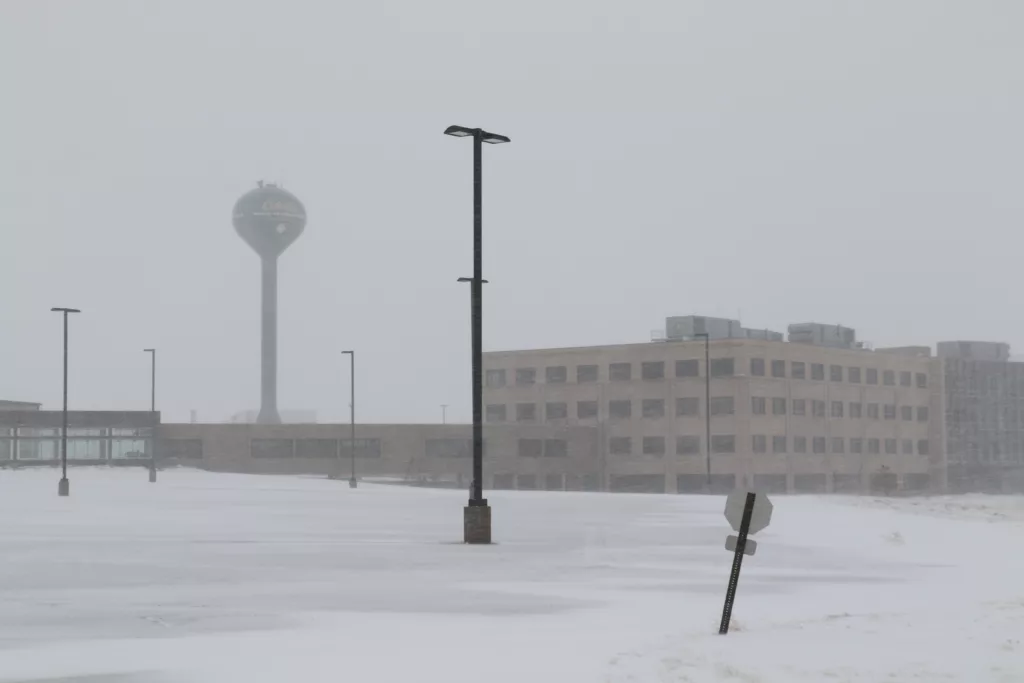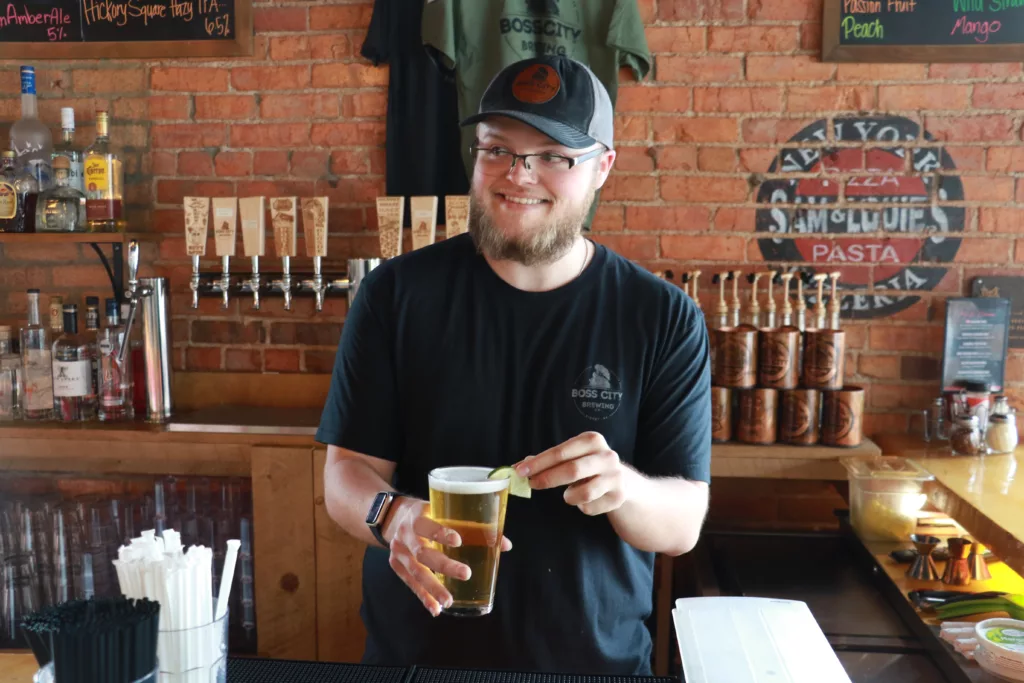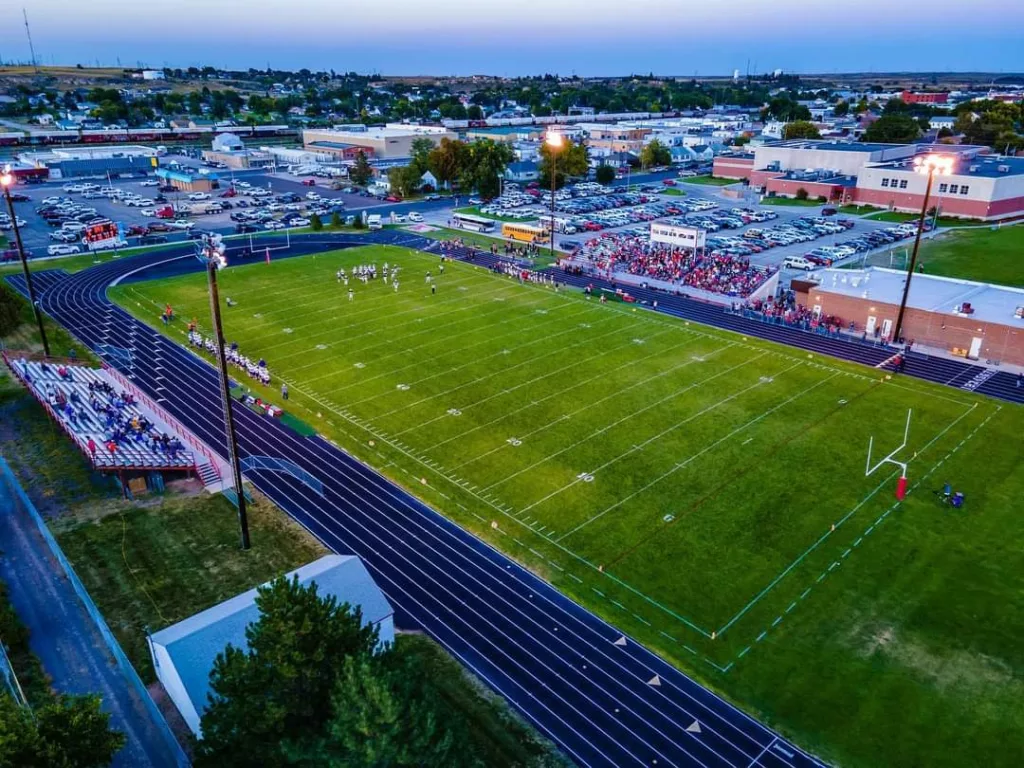SIDNEY – The forest green roof and pair of bronze stags frozen in combat are impossible to miss as you drive down Interstate 80.
Next to the storefront built to mimic a log cabin stand the two corporate buildings – 550,000 square feet of nearly empty office space, long offered for a $1 per-year lease. But there are no takers.
The water tower looms over it all, painted in the same forest green, heralding what once was: “Cabela’s World Headquarters, City of Sidney.”
For 54 years, Cabela’s made its home here, the economic juggernaut that kept the town growing while others shrunk. But in 2017, the sporting goods store sold for $5 billion to Bass Pro Shops – a takeover that at the time meant the staggering loss of about 2,000 jobs in this town of roughly 6,600 residents.

Expectations for Sidney’s future turned grim. Without Cabela’s, it was feared that the fourth-largest city in the Panhandle would become a ghost town. As one full-page ad in the local paper declared, Last one out, turn off the lights.
“It was the identity of Sidney forever,” said Cory Keen, a former Cabela’s employee. “So of course, people must think that, ‘Oh, Cabela’s isn’t here, Sidney must not be here.’”
But six years later, the lights are still on. The reality in this Panhandle town: Complicated.
Sidney’s population did shrink in the years after the sale – but then started growing again in 2020. The town has lost an estimated 436 residents since 2016, a 6% dip that mirrors population declines in similar Nebraska cities.
The numbers don’t signal a full recovery – Sidney’s median income, for example, has plummeted with the loss of Cabela’s high-paying corporate jobs.

But Sidney’s staying power still surprises experts, who say it’s driven by two factors.
One: Former Cabela’s employees opening their small businesses, diversifying the economy in a formerly one-company town.
Two: A recent influx of new residents, both retirees and remote workers.
“I would have predicted at least a 20% (population) decline,” said Don Macke, a rural community development consultant who has worked in Sidney. “When you lose an employer of this size, and…a few years later, we’ve got a population that’s comparable to what it was before, that’s pretty unprecedented.”
****
Every spring for the past three years, high school juniors and seniors from across Nebraska and neighboring states flock to Sidney searching for the perfect prom dress. Their destination: Charlotte & Emerson, a downtown boutique and dress shop – and one example of Sidney’s rebirth from the ashes of Cabela’s.
Co-owner Sarah Kaiser and her husband Kurt Kaiser both worked at Cabela’s. When the company was swallowed by Bass Pro, the family moved to Springfield, Missouri, where Bass Pro is headquartered. There, Sarah Kaiser led human resources for the combined companies.
But in 2020, they decided to return to Sidney, her hometown. Sarah Kaiser opened Charlotte & Emerson with her sister. Her husband launched an online fitness gear store, Frost Giant Fitness. They’re two of many Sidney-based companies run by ex-Cabela’s employees who decided to stick around and start something new.

“The corporate experience of these young folks really was key to this particular recovery,” said David Iaquinta, a Nebraska Wesleyan University sociology professor who has researched Sidney’s economic development. “There wasn’t an inherent natural resource that was going to save them, like oil. Instead, they combined that talent with a strong desire for the lifestyle that they had. They said, ‘we’re here. We’re rooted here.’”
Part of the economic recovery in Sidney has been participating in E3, a program through the Nebraska Community Foundation meant to boost entrepreneurship and development in rural Nebraska.
Already, new businesses have remodeled once-dilapidated buildings, said Sarah Sinnett, the program’s community lead and a former Cabela’s employee. This year, E3 partnered with Sidney Public Schools to hire an entrepreneurial navigator – a privately funded role to help new and existing small business owners grow their companies in town.

“Economic development in Nebraska…used to be about cheap land, cheap labor, cheap incentives to get big companies to relocate their businesses,” Sinnett said. “If you want small towns to start thriving and continuing to grow, really it needs to be focused on entrepreneurship.”
Small business success and failure often exist on the same block in Sidney.
Next door to Charlotte & Emerson, the e-commerce company G.L. Huyett opened its expanded offices in downtown Sidney, with a shining new sign and the promise to grow their staff from nine to 25.
Just across the street, there’s an empty storefront with a tattered awning. A Greek restaurant on the corner that now has a boarded up door and permanent closed sign.
Two blocks away, a closed vintage store’s windows are papered over. Across the street, Dawson Sharman, a promising young entrepreneur, runs Petals Flowers, the flower shop she bought late last year.
“They open up and they shut down,” said Carla Lutz, a former Cabela’s employee who’s lived in Sidney for 16 years. “It’s like businesses can’t get a foothold here. It’s hard to tell who’s open.”
In the three years that Vinod Sabhaya has owned Rodeway Inn & Suites in Sidney’s downtown, he said he’s watched nearly a dozen nearby businesses close.
His hotel, which sits 5 miles from the cluster of hotels and restaurants near I-80, has 47 rooms. On a given night, he fills 15 at most. If business doesn’t improve over the next year, he’ll likely sell.

“If I spend more money, it’s just garbage. There’s no return,” Sabhaya said.
Losing Cabela’s did mean some loss of clientele, several business owners said. Some fear that acknowledging the decline will hurt business all over again.
“The first time around was bad enough,” one business owner said, declining an interview.
Sharman, owner of Petals Florals, was in high school when Cabela’s went away. Her grandmother worked at the company. Sharman doesn’t remember much of the impact. But she sees it when looking at the flower shop’s old monthly receipts.
“It was so much busier back then,” Sharman said. “It made so many people move out.”
When Bass Pro bought Cabela’s, the number of homes for sale more than doubled, to an unheard-of 150. So many that realtor Stephen Wolff ran out of the “For Sale” signs he handmakes himself.
The exodus caused a demographic shakeup.
“Sidney’s manufacturing industry has grown the most consistently since the merger,” replacing Cabela’s white-collar corporate positions, said Brittany Hardin, the Nebraska Department of Economic Development’s western Nebraska business development consultant. “That includes companies that were established by Nebraskans, as well as manufacturers who came in from outside our state to invest here.”
The change can be seen in census data. From 2017 to 2021, the median household income in Sidney dropped from $61,667 to $49,812. The number of people making more than six figures went from 335 to 111, according to annual census surveys.

The young adults and young families Cabela’s recruited also seem to be replaced by retirees – people living in Denver and the Front Range of Colorado, who realized they could buy a similar home for half the price in Sidney.
From 2017 to 2021, the share of people 65 and older jumped to nearly a fifth of the population.
“I think we’re still trying to figure out what that looks like in a community,” said Melissa Norgard, the city’s former economic development director. “Because it’s completely changed.”
Whether that’s a sign of recovery in Sidney depends who you ask.
“They aren’t bringing jobs to Sidney,” Lutz said. “And they also aren’t working jobs.”
But retirees can be a giant resource, Macke said. A few more years of census data will shed light on just how many have relocated to Sidney.
“They often invest in businesses, they often mentor, they run for school board,” Macke said. “Even if it was all retirees, that’s still a huge human talent potential for the community.”

Another wave of people took advantage of Sidney’s cheap housing market, driven largely by the pandemic: remote workers.
Sidney “benefited hugely from that desire of people in the Front Range to escape what they perceive as over-urbanization. That meant both retirees and people that had flexibility in their employment, that could work remotely,” Iaquinta said. “The pandemic…was a fueling agent that expanded this.”
The rise in remote work helped people already living in Sidney, too, Keen said, as former Cabela’s workers who stayed in town started finding good jobs based elsewhere.
Keen was one of the few Cabela’s employees left at the Sidney corporate office after the merger. But in 2020, he left the company to join Nelnet as a software development manager.
The Lincoln-based company hired employees in Sidney entirely remote. It didn’t open an in-person office until 2021, growing to a staff of 81.
“I worked out of my home,” said Keen, who now leads Nelnet’s Sidney office. “Which wasn’t necessarily something you could just easily find and do until the pandemic hit.”
***

Cabela’s 2017 departure triggered a staggering 2,000 job losses – nearly one job loss for every three Sidney residents. But Sidney has confounded the most dire predictions for its future in the six years since Cabela’s left. It’s starting to regain some population, and experts see signs that it’s diversifying its economy away from the boom-and-bust cycle that marked most of Sidney’s history. Courtesy Photo
The story of Sidney is a history of booms and busts. The construction of the transcontinental railroad in the 1860s. The Army ammunition depot that spiked during World War II then closed after Vietnam. For large stretches, it’s been a town driven by one industry, a lone major employer.
In 1963, Cabela’s sparked the latest boom, quickly becoming the backbone of Sidney’s economy.
One example: Sidney Mayor Brad Sherman, who is also an operations manager at UPS, said that the shipping company would move as many as 2,000 packages a day for the outdoor outfitter. Three UPS employees exclusively focused on Cabela’s. Between Thanksgiving and Christmas, UPS would ship out 20 to 30 trailers a day loaded with Cabela’s items.
The flagship store drove tourism into Sidney, too. Buses of visitors would arrive in the parking lot, to shop and see the array of taxidermied wildlife inside. The passengers of the occasional private jet would land at the regional airport, head to Cabela’s, spend thousands on hunting equipment, then fly home, Sherman said.
Many families had their entire incomes coming from Cabela’s, making the merger that much more terrifying, several former employees said.
Bass Pro claimed it would keep a few hundred employees in Sidney, sparing the call center and distribution center as well. By 2019, they were all emptied out.
“What city of 6,400 people loses 2,000 high-paying jobs? How do you come back from that?” said David Scott, Sidney city manager. “There was not a lot of hope for us. And that kind of fueled the fire for us.”
Sidney leaders poured money into trying to attract new businesses to replace the 2,000 lost jobs. In five years, the city has awarded $3.74 million in economic development funds to 14 companies, each pledging to bring in anywhere from 10 to 150 jobs.
The corporate offices are still “the elephant in the room,” Scott said. “We’ve tried everything we can to market those.”
People have ideas: An office park. A trade school, maybe.
But even if a company brought dozens of families into town, there’d be nowhere for them to live, said Wolff, the local realtor. In mid-March, there were only about 30 homes on the market in Cheyenne County.
“You’d be reluctant to move to a town where you didn’t think you’d have a house to live in,” Sherman said. “And vice versa, you’d be reluctant to build a house in a town where you didn’t think there were going to be any businesses.”
Filling the building with one big company would be a mistake, Macke said.
“The worst thing that could happen is some other major employer comes into that big building and Sidney simply becomes dependent on one more big thing,” Macke said. “Otherwise, they’re going to continue to go through this boom and bust cycle. And at some point, they may not have the resiliency to reinvent themselves.”
Sinnett said she hopes the new entrepreneurship program will make it easier for small business owners to get started in Sidney – easier to secure funding and to understand how to create a business plan. There are plans to start a local investment club, where entrepreneurs who don’t qualify for a bank loan could seek funds from local investors. It’s all part of the ongoing effort to diversify Sidney’s economy.
It may work, experts say. It may not. But Sidney’s story is undoubtedly still being written.
“We may lose a business, but if we focus on keeping the talent there, that’s a huge lesson for Nebraska,” Macke said. “They’re just in their first act post-Cabela’s.”
The Seacrest Greater Nebraska reporter covers issues across the state of Nebraska. It is named in honor of philanthropist Rhonda Seacrest and her late husband James, who proudly led several Nebraska newspapers through Western Publishing for 40 years.



6 Comments
Very interesting, Thank you.
Iam a 26 year vet of Cabela’s. The greatest company I had ever worked for. Now I am applying those lessons and vision to my own business here in downtown Sidney. Love these people.
Cabels leaving Sidney had a huge regional impact. Many people from Colorado commuted to Sidney to work there. I wonder how many of those 2000 employees included these commuters.
Considering the locstion in the center of the US with I80 the two railroads and the old sioux army depot nearby Sidney should attract a manufacturing plant of some type to locate or expand there operations to the community. I agree that putting all of the eggs in one basket is not the way to go, but 2000 small businesses paying slightly above poverty wages is not the answer either. Being close minded to the possibility of a rather large business moving or expanding into Sidney or the surrounding area is not the solution. Having multiple small businesses with a higher closing rate is no solution to Sidney’s economic future…. maybe good for a bankruptcy law firm and moving company but not for Sidney’s future.
Excellent story not explored by other Nebraska media that I’m aware of.
Great article. I feel for the people of this town. I think it would be wise for the city leaders to listen to this: https://www.strongtowns.org/journal/2017/9/5/a-beginners-guide-to-economic-gardening-free-webcast and think about the value of economic gardening above trying to recruit new businesses to the town.